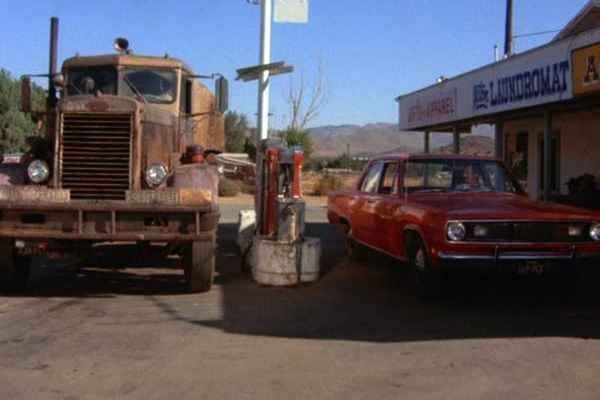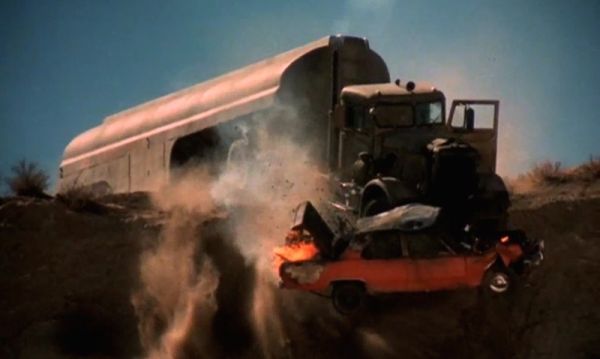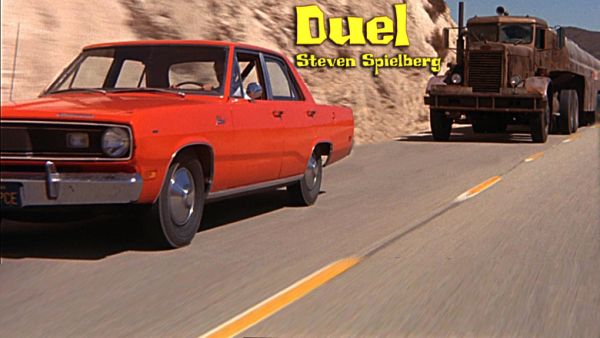Genre: Thriller / Screenplay: Richard Matheson / Budget: 450,000 USD / Country: United States / Director: Steven Spielberg / Story: Richard Matheson / Duration: 90 min / Release date: November 13, 1971 / Writer: Richard Matheson (screenplay), Richard Matheson (story) / Initial release: November 10, 1971 (Canada) / Cast: Dennis Weaver (David Mann), Eddie Firestone (Cafe Owner), Eugene Dynarski (Man in Cafe), Tim Herbert (Gas Station Attendant), Charles Seel (Old Man), Alexander Lockwood (Old Man in Car) / Tagline: Fear is the driving force
Duel is a 1971 television (and later full-length theatrical) thriller film directed by Steven Spielberg and written by Richard Matheson, based on Mathesons short story of the same name. It stars Dennis Weaver as a terrified motorist stalked on a remote and lonely road by the mostly unseen driver of a mysterious tanker truck. Travelling businessman, David Mann, angers the driver of a rusty tanker whilst crossing the Californian desert. A simple trip turns deadly as Mann struggles to stay on the road while the tanker plays cat and mouse with his life.
Plot
David Mann is a middle-aged salesman driving on a business trip. On a two-lane highway in the California desert, he encounters a grimy tanker truck, traveling slower than the speed limit and expelling sooty diesel exhaust. Mann overtakes, but the truck roars past him and slows down again. Mann overtakes again; the truck blasts its horn.
Mann arrives at a gas station, and the truck follows. Mann phones his wife, who is upset with him after an argument last night. The gas station attendant refills Manns car and mentions that it needs a new radiator hose. Mann refuses the repair.

Back on the road, the truck blocks Mann's path each time he attempts to pass. The unseen driver waves Mann past, indicating it is safe to overtake, but when Mann passes he almost strikes an oncoming vehicle. Mann realizes the truck driver was trying to trick him into a fatal collision. He passes the truck again, using an unpaved turnout next to the highway.
The truck tailgates Mann at high speeds, forcing Mann to maintain his speed to avoid being rear-ended. After the truck bumps him several times, Manns car goes off the road and collides with a fence opposite a diner. The truck continues down the road.
Mann enters the diner to compose himself. Returning from the restroom, he is shocked to see the truck parked outside. Mann studies the diner patrons and confronts the man who believes is the truck driver; he hits Mann and drives away in a different truck. The tanker truck leaves seconds later; its driver was not inside the diner after all.
Mann leaves the diner and stops to help a stranded school bus, but his front bumper becomes caught underneath the buss rear bumper. The truck appears at the end of a tunnel. Mann panics, manages to free his car, and flees. The truck helps the bus get moving. At a railroad crossing, the truck pushes Manns car towards a passing freight train. The train passes just in time; Mann crosses the tracks and pulls off the road. The truck passes and disappears. Mann finds it waiting for him further down the road.
Mann stops at a gas station to call the police and refuel his car. When Mann steps into a phone booth, the truck drives into it; Mann jumps clear just in time. Mann jumps into his car and speeds away. He hides behind an embankment and the truck drives past.
After a long wait, Mann heads off again but finds the truck waiting for him around the bend. Mann stops his car, then attempts to speed past the stopped truck, but it moves across the road, blocking his way. He approaches the stopped truck on foot, but it drives slowly away, keeping just ahead of Mann. He seeks help from an older couple in a car, but they flee when the truck backs up towards them at speed. The truck stops before hitting Manns car, then waves him past.
Mann speeds around the truck and races up steep grades, putting distance between himself and the truck. He sees a black-and-white car parked on the side of the road, and thinking it is a police car skids to a stop, but finds it is a pest control vehicle. The chase continues up a mountain, but Manns car begins to overheat when its radiator hose fails. Mann barely makes the summit and coasts downhill in neutral as the truck bears down on him.
Mann spins out and hits a rock wall. The truck speeds toward the car as Mann accelerates, drives up a dirt road, and turns to face his opponent on a hill overlooking a canyon. He places his briefcase on the accelerator and steers toward the oncoming truck, jumping from the car at the last moment. The tanker hits the car, which bursts into flames, obscuring the truck drivers view. The truck plunges over the cliff. Above the wreckage, Mann sits exhausted at the cliffs edge.
Production
The script is adapted by Richard Matheson from his own short story, originally published in Playboy magazine. It was inspired by a real-life experience in which Matheson was tailgated by a trucker while on his way home from a golfing match with friend Jerry Sohl on November 22, 1963, the same day as the John F. Kennedy assassination. The short story was given to Spielberg by his secretary, who reportedly read the magazine for the stories.
Duel was Spielbergs second feature-length directing effort, after his 1971 The Name of the Game NBC television series episode "L.A. 2017". It was two years after directing a segment of the pilot for the anthology television series Night Gallery and several other TV episodes. Duel was initially shown on American television as an ABC Movie of the Week installment. It was eventually released to cinemas in Europe and Australia, and had a limited cinema release to some venues in the United States. The films success enabled Spielberg to establish himself as a film director.
Much of the movie was filmed in and around the communities of Canyon Country, Agua Dulce, and Acton, California. In particular, sequences were filmed on Sierra Highway, Agua Dulce Canyon Road, Soledad Canyon Road, and Angeles Forest Highway. Many of the landmarks from Duel still exist today, including the tunnel, the railroad crossing, and Chucks Cafe, where Mann stops for a break. The building, which since 1980 has housed a French restaurant called Le Chene, is currently still on Sierra Highway. The "Snakerama" gas station seen in the film was used as a homage to Duel by Spielberg in his comedy film, 1941 (1979), with Lucille Benson again appearing as the proprietor.
Production of the television film was overseen by ABCs director of movies of the week, Lillian Gallo. The original made-for-television version was 74 minutes long and its filming was completed in 13 days (three longer than the scheduled 10 days), leaving 10 days for editing prior to broadcast as the ABC Movie of the Week. Following Duel???s successful TV airing, Universal released the film overseas in 1972. Since the TV movie was not long enough for theatrical release, Universal had Spielberg spend two days filming several new scenes, turning Duel into a 90-minute film. The new scenes were set at the railroad crossing, school bus, and the telephone booth. A longer opening sequence was added with the car backing out of a garage and driving through the city. Expletives were also added, to make the film sound less like a television production.
Spielberg lobbied to have Dennis Weaver in the starring role because he admired Weavers work in Orson Welles Touch of Evil. Weaver repeats one of his lines from the Welles classic, telling the truck driver in the cafe that he has "another think coming."
In the Archive of American Television website, Spielberg is quoted in an interview given by Weaver as saying: "You know, I watch that movie at least twice a year to remember what I did".
Vehicles
Though the car was carefully chosen – a red Plymouth Valiant – three cars were used in the filming. The original release featured a 1970 model with a 318 V-8 engine and "Plymouth" spelled out in block letters across the hood, as well as trunk lid treatment characteristic of the 1970 model; a 1971 model with a 225 Slant Six was also used. When the film was released in theatres and scenes were added, a 1972 model with a 225 Slant Six was added, with the "Plymouth" name on the hood as one emblem. All three cars were dressed with wheel covers available only to Valiant models, only in 1971.
The Valiants red color was also intentional; Spielberg did not care what kind of car was used in the film but wanted it to be a red car to enable the vehicle to stand out in the wide shots of the desert highway.
Spielberg had what he called an "audition" for the truck, wherein he viewed a series of trucks to choose the one for the film. He selected the older 1955 Peterbilt 281 over the then-current flat-nosed "cab-over" style of trucks because the long hood of the Peterbilt, coupled to its split windshield and round headlights, gave it more of a "face", adding to its menacing personality. Additionally, Spielberg said the multiple license plates on the front bumper of the Peterbilt subtly suggested that the truck driver is a serial killer, having "run down other drivers in other states". For each shot, several people were tasked to make it uglier, adding some "truck make-up". The shots of the truck are done in such a way as to make it seem "alive" in terms of its attack on Mann.
The truck had twin rear axles, a Cummins NTC 350 turbocharged engine with a 5-speed main transmission and a 3-speed auxiliary transmission, making it capable of hauling loads over 30 tons and top speeds reaching 75-80mph. During the original filming, the crew only had one truck, so the final scene of the truck falling off the cliff had to be completed in one take. For the films theatrical release, though, additional trucks were purchased in order to film the additional scenes that were not in the original made-for-television version (the school bus scene and the railroad crossing scene). Only one of those trucks has survived.
Stock footage of both vehicles was later used in an episode of the television series The Incredible Hulk, titled "Never Give a Trucker an Even Break". Spielberg was not happy about this, but the usage was legal as the show was produced by Universal, and the Duel contract said nothing about reusing the footage in other Universal productions.
The truck was purchased several times. It is currently owned by a truck collector and is on display at Brads Trucks in North Carolina.
Music
The films original score was composed by Billy Goldenberg, who had previously written the music for Spielbergs segment of the Night Gallery pilot and his Columbo episode "Murder by the Book," and co-scored Spielbergs The Name of the Game episode "L.A. 2017" with Robert Prince. Spielberg and Duel producer George Eckstein told him that because of the short production schedule, he would have to write the music during filming, and Goldenberg visited the production on location at Soledad Canyon to help get an idea of what would be required. Spielberg then had Goldenberg ride in the tanker truck being driven by stunt driver Carey Loftin on several occasions; the experience terrified the composer, although he did eventually get used to it. Goldenberg then composed the score in about a week, for strings, harp, keyboards and heavy use of percussion instruments, with Moog synthesiser effects but eschewing brass and woodwinds. He then worked with the music editors to "pick from all the pieces (they) had and cut it together (with the sound effects and dialogue)." Much of his score was ultimately not used in the finished film.
Soundtrack album
In 2015 Intrada Records released a limited edition album featuring the complete score, plus four radio source music tracks composed by Goldenberg.
Critical response
The film received many positive reviews and is often considered among the greatest TV movies. On Rotten Tomatoes the film currently has a "Fresh" score of 86% based on 37 reviews with an average rating of 7.7 out of 10.).
Accolades
- Awards
- Avoriaz Fantastic Film Festival: Grand Prize: 1973
- Emmy: Outstanding Achievement in Film Sound Editing: 1972
- Golden Globe: Best Movie Made for TV: 1972
- Emmy: Outstanding Achievement in Cinematography for Entertainment Programming – For a Special or Feature Length Program Made for Television: 1972
- Saturn Award: Best DVD Classic Film Release: 2005
- "Steven Spielberg and Duel: The Making of a Film Career" by Steven Awalt, Rowman & Littlefield (2014)
- The Complete Spielberg by Ian Freer, Virgin Books (2001)
- Steven Spielberg by James Clarke, Pocket Essentials (2004)
- Steven Spielberg The Collectors Edition by Empire Magazine (2004)
- The Steven Spielberg Story by Tony Crawley, William Morrow (1983)
- Duel by Richard Matheson, Tor Books Terror Stories Series (2003)
Duel @ Wikipedia
Duel @ Rotten Tomatoes
Duel @ IMD
Duel @ www.themoviedb.org


